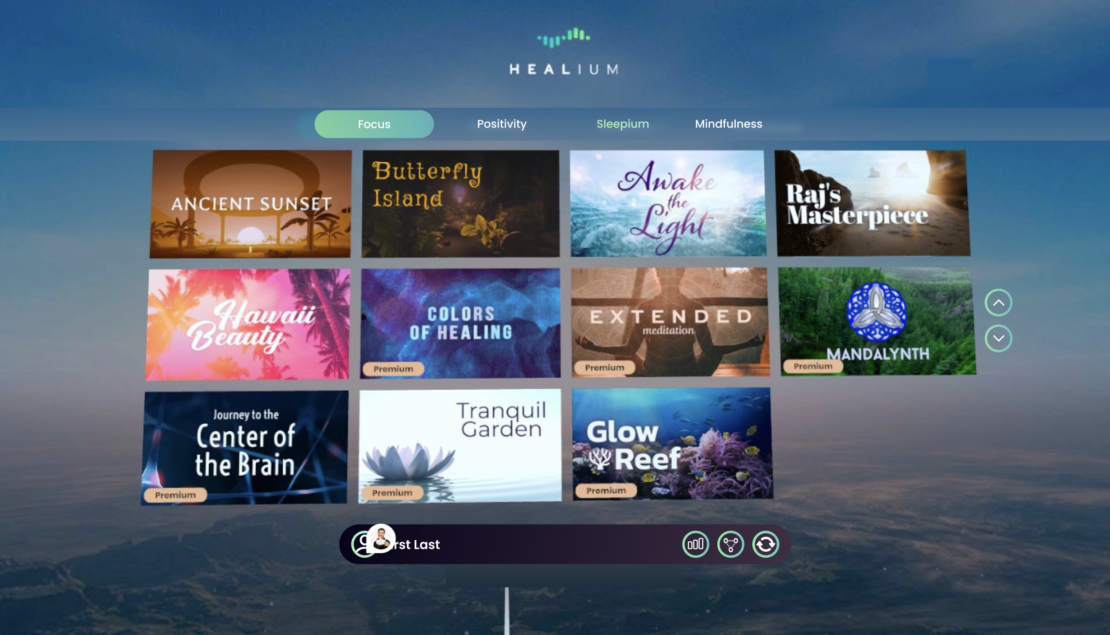




While previous research has demonstrated the potential benefits of virtual reality and biofeedback for cancer patients, this study is the first to combine these innovative technologies as a non-pharmacologic intervention during active cancer treatment.

Jump to: What is Healium? | The Study | The Results | Implications for Cancer Care
Interest in complementary and alternative medicine has led to a new study exploring Healium’s use of virtual reality (VR) and neurofeedback for cancer symptom management.
Using Healium as a non-pharmacologic intervention shows promise in managing cancer-related pain and mood, offering an innovative approach to enhance patients’ well-being during treatment.
VR applications like Healium have gained traction in healthcare settings as non-pharmacologic tools to alleviate pain and discomfort. Healium is an immersive mental fitness tool that transports users to virtual reality environments to self-manage the perception of pain and anxiety, ultimately enhancing a patient’s overall treatment experience.
However, what separates Healium from other mental fitness tools is how it leverages the power of neurofeedback and biofeedback.
Neurofeedback is a technique that involves real-time monitoring of brainwave activity. With access to brainwave data, the doorway to retraining or reorganizing brain signals opens, allowing individuals to learn how to self-regulate them. In other words, by training the brain to produce specific patterns associated with relaxation and positive emotions, neurofeedback holds the potential to improve mood and alleviate pain.
This self-regulation of brain activity empowers patients to exert some control over their physical and emotional states, complementing traditional pain management strategies and enhancing their coping mechanisms during cancer treatmen, not as a replacement for psychotropic medication or professional counseling but as part of their meditation practice.
Researchers enlisted 15 cancer patients who were actively undergoing treatment, utilizing a mixed-methods approach. These participants engaged in a 22-minute irtual reality experience that immersed them in Healium’s nature scenes, while simultaneously wearing a Brainlink Lite EEG headband to measure their brain’s EEG activity.
To evaluate the effectiveness of the intervention, the researchers conducted pre- and post-experience assessments using the Edmonton Symptom Assessment System revised version (ESAS-r) to measure the patients’ pain and anxiety levels. This assessment is considered the gold standard for assessing cancer symptoms. Participants were also asked to complete the ESAS-r midway through the VR experience.
Following the intervention, a follow-up interview was also conducted to gather qualitative insights into the patients’ experiences.
The study’s results were compelling and demonstrated the potential of this combined approach.
Notably, all participants (100%) successfully completed the virtual reality and neurofeedback intervention, indicating its acceptability among cancer patients.The patients also reported decreased levels of depression and anxiety. Statistically significant reductions in pain (p < .001) were observed between the pre-intervention (T1) and post-intervention (T3) ESAS-r assessments, suggesting a positive impact on pain management.
This study not only revealed the feasibility and effectiveness of integrating virtual reality with neurofeedback but also highlighted its potential as a promising intervention for managing cancer symptoms during treatment.
Notable quotes from the patients included:
“[This intervention] is calming … more relaxing, while actually going through treatment…[The virtual reality experience] calmed my mind, and I actually felt like I could breathe better.”
“[This intervention] definitely changed my emotional state…The actual visuals switched my emotional state, too … like, [feeling] larger than myself … like tapping into that internal sense of … wonder and awe. I didn’t notice the pain at all during the experience…. Until you asked, I was completely unaware of my pain.”
The findings of this study hold significant implications for the future of cancer care.
While previous research has demonstrated the potential benefits of virtual reality and neurofeedback for cancer patients, this study is the first to combine these innovative technologies as a non-pharmacologic intervention during active cancer treatment.
The results indicate that the virtual reality and neurofeedback intervention is not only feasible but also shows promise in effectively managing pain and anxiety among cancer patients. This study paves the way for larger efficacy trials, which could provide deeper insights into the effectiveness of this combined intervention for cancer symptom relief.
In light of these exciting developments, we encourage readers to learn more about Healium and the additional peer-reviewed studies that have shown equally exciting promise.